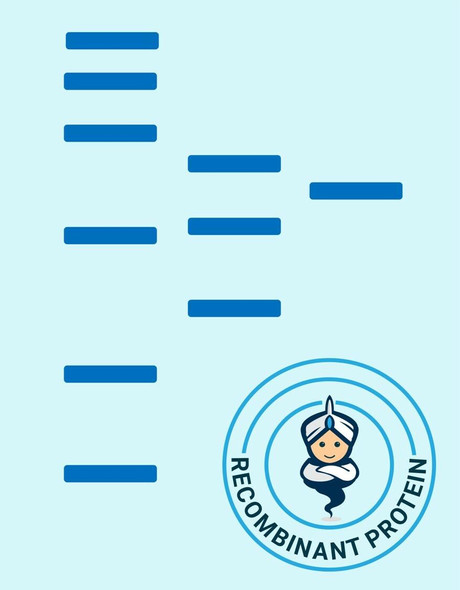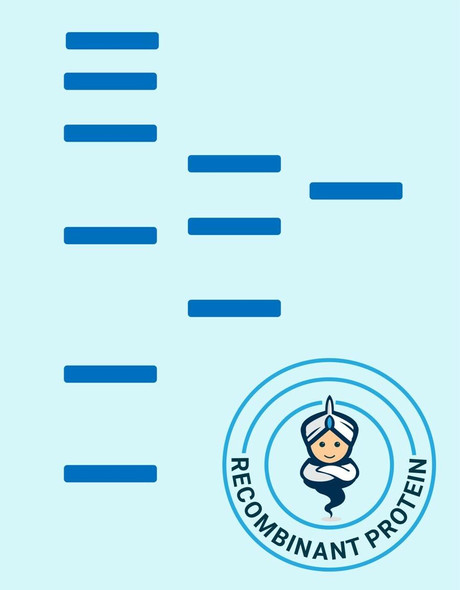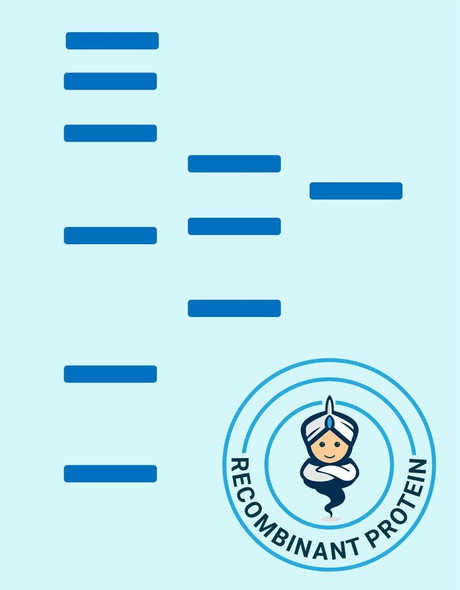Human HUS1 Recombinant Protein (RPPB3722)
- SKU:
- RPPB3722
- Product type:
- Recombinant Protein
- Size:
- 5ug
- Species:
- Human
- Target:
- HUS1
- Synonyms:
- HUS1 Checkpoint Homolog (S pombe)
- Checkpoint Protein HUS1
- Hus1+-like protein
- Source:
- Escherichia Coli
- Uniprot:
- O60921
Description
| Product Name: | Human HUS1 Recombinant Protein |
| Product Code: | RPPB3722 |
| Size: | 5µg |
| Species: | Human |
| Target: | HUS1 |
| Synonyms: | HUS1 Checkpoint Homolog (S. pombe), Checkpoint Protein HUS1, Hus1+-like protein. |
| Source: | Escherichia Coli |
| Physical Appearance: | Sterile Filtered clear solution. |
| Formulation: | The HUS1 protein solution (0.25mg/1ml) is formulated in . In 20 mM Tris-HCl Buffer (pH 8.0), 100 mM NaCl and 40% Glycerol. |
| Stability: | Store at 4°C if entire vial will be used within 2-4 weeks. Store, frozen at -20°C for longer periods of time.Please avoid freeze thaw cycles. |
| Purity: | Greater than 95% as determined by SDS-PAGE. |
| Amino Acid Sequence: | MGSSHHHHHH SSGLVPRGSH MKFRAKIVDG ACLNHFTRIS NMIAKLAKTC TLRISPDKLN FILCDKLANG GVSMWCELEQ ENFFNEFQME GVSAENNEIY LELTSENLSR ALKTAQNARA LKIKLTNKHF PCLTVSVELL SMSSSSRIVT HDIPIKVIPR KLWKDLQEPV VPDPDVSIYL PVLKTMKSVV EKMKNISNHL VIEANLDGEL NLKIETELVC VTTHFKDLGN PPLASESTHE DRNVEHMAEV HIDIRKLLQF LAGQQVNPTK ALCNIVNNKM VHFDLLHEDV SLQYFIPALS |
HUS1 is a component of an evolutionarily conserved, genotoxin-activated checkpoint complex. HUS1 protein connects with Rad9 and Rad1 to form the 9-1-1(RAD9-RAD1-HUS1) complex, that confines to DNA lesions and promotes DNA damage signaling and repair or apoptosis, cell cycle arrest. The trimeric complex is structurally similar to the proliferating cell nuclear antigen (PCNA) sliding clamp and interacts with Rad17 as a clamp-clamp loader pair during the DNA damage response.
HUS1 produced in E.Coli is a single, non-glycosylated polypeptide chain containing 300 amino acids (1-280a.a.) and having a molecular mass of 33.8kDa.HUS1 is fused to a 20 amino acid His-tag at N-terminus & purified by proprietary chromatographic techniques.
| UniProt Protein Function: | HUS1: Component of the 9-1-1 cell-cycle checkpoint response complex that plays a major role in DNA repair. The 9-1-1 complex is recruited to DNA lesion upon damage by the RAD17-replication factor C (RFC) clamp loader complex. Acts then as a sliding clamp platform on DNA for several proteins involved in long-patch base excision repair (LP-BER). The 9-1-1 complex stimulates DNA polymerase beta (POLB) activity by increasing its affinity for the 3'-OH end of the primer-template and stabilizes POLB to those sites where LP-BER proceeds; endonuclease FEN1 cleavage activity on substrates with double, nick, or gap flaps of distinct sequences and lengths; and DNA ligase I (LIG1) on long-patch base excision repair substrates. The 9-1-1 complex is necessary for the recruitment of RHNO1 to sites of double-stranded breaks (DSB) occurring during the S phase. Belongs to the HUS1 family. |
| UniProt Protein Details: | Protein type:DNA repair, damage; Cell cycle regulation Chromosomal Location of Human Ortholog: 7p13-p12 Cellular Component: nucleoplasm; cytoplasm; nucleolus; nucleus Molecular Function:protein binding Biological Process: regulation of protein amino acid phosphorylation; embryonic development; negative regulation of DNA replication; mitotic cell cycle checkpoint; DNA damage checkpoint; DNA repair; DNA replication; response to DNA damage stimulus; protein amino acid phosphorylation; double-strand break repair via homologous recombination; response to UV |
| NCBI Summary: | The protein encoded by this gene is a component of an evolutionarily conserved, genotoxin-activated checkpoint complex that is involved in the cell cycle arrest in response to DNA damage. This protein forms a heterotrimeric complex with checkpoint proteins RAD9 and RAD1. In response to DNA damage, the trimeric complex interacts with another protein complex consisting of checkpoint protein RAD17 and four small subunits of the replication factor C (RFC), which loads the combined complex onto the chromatin. The DNA damage induced chromatin binding has been shown to depend on the activation of the checkpoint kinase ATM, and is thought to be an early checkpoint signaling event. Alternative splicing results in multiple transcript variants. [provided by RefSeq, Feb 2011] |
| UniProt Code: | O60921 |
| NCBI GenInfo Identifier: | 74735462 |
| NCBI Gene ID: | 3364 |
| NCBI Accession: | O60921.1 |
| UniProt Secondary Accession: | O60921,B4DFI9, |
| UniProt Related Accession: | O60921 |
| Molecular Weight: | 280 |
| NCBI Full Name: | Checkpoint protein HUS1 |
| NCBI Synonym Full Names: | HUS1 checkpoint homolog (S. pombe) |
| NCBI Official Symbol: | HUS1 |
| NCBI Official Synonym Symbols: | hHUS1 |
| NCBI Protein Information: | checkpoint protein HUS1; hus1+-like protein |
| UniProt Protein Name: | Checkpoint protein HUS1 |
| Protein Family: | Checkpoint protein |
| UniProt Gene Name: | HUS1 |
| UniProt Entry Name: | HUS1_HUMAN |









